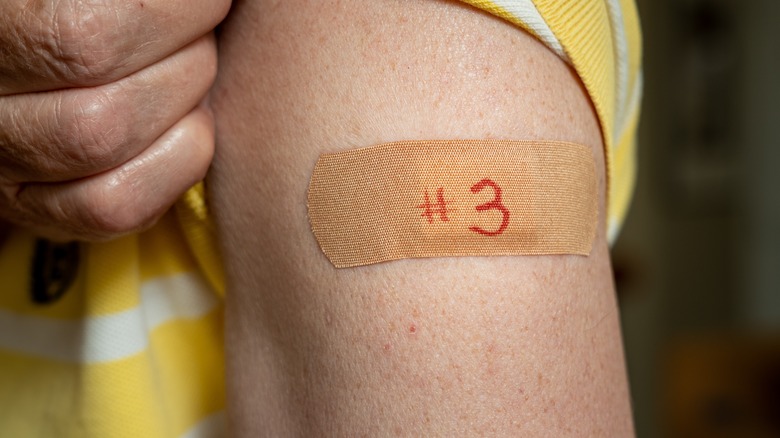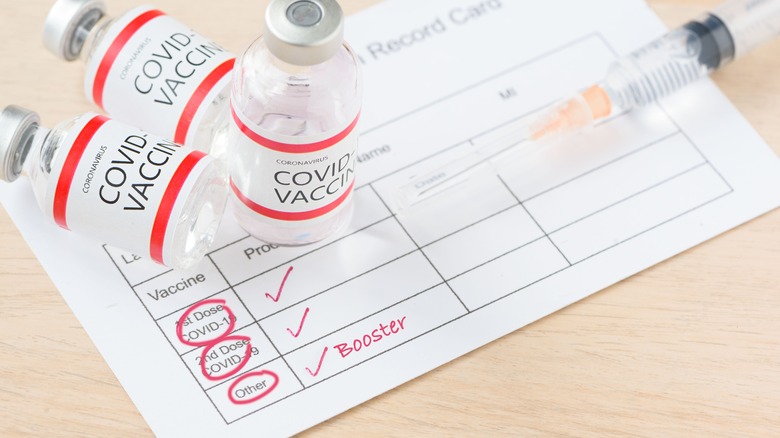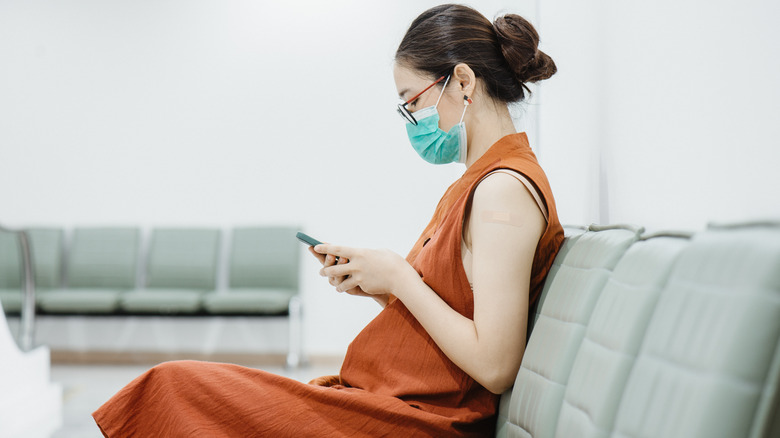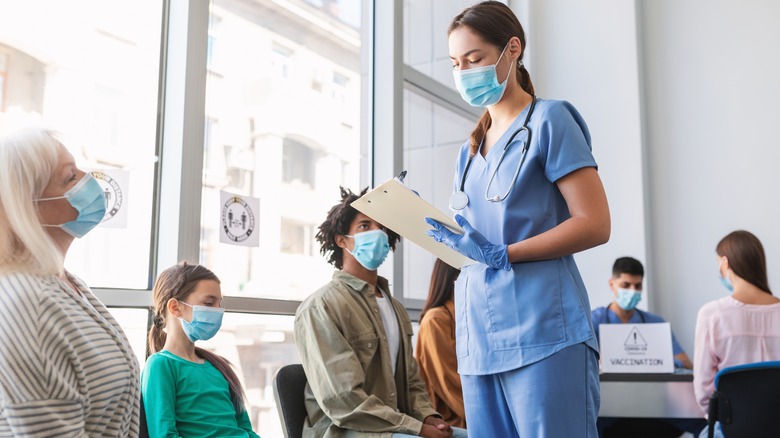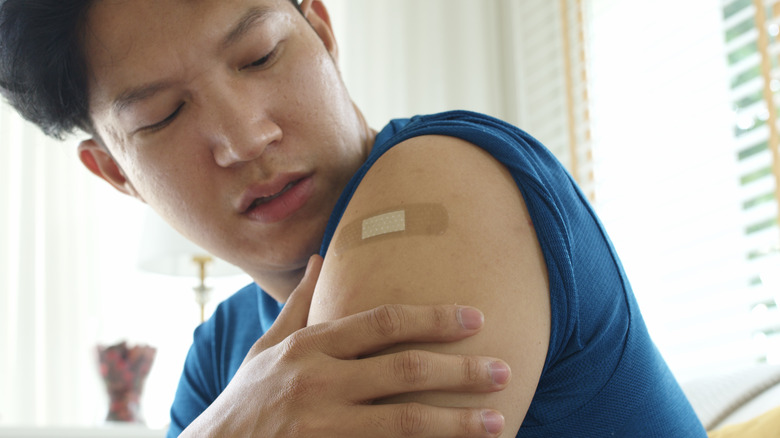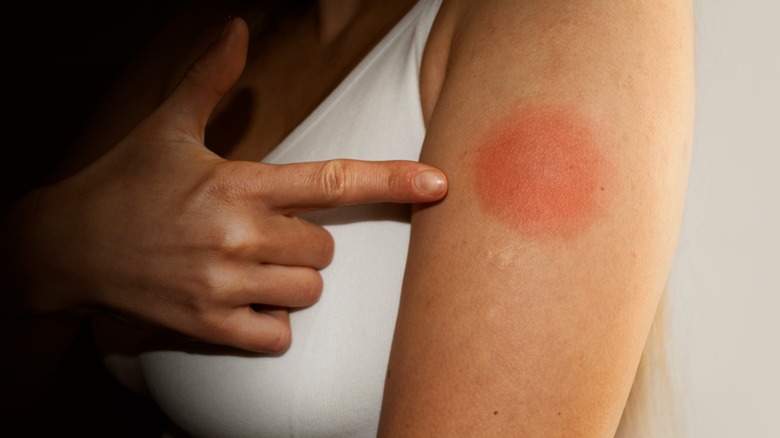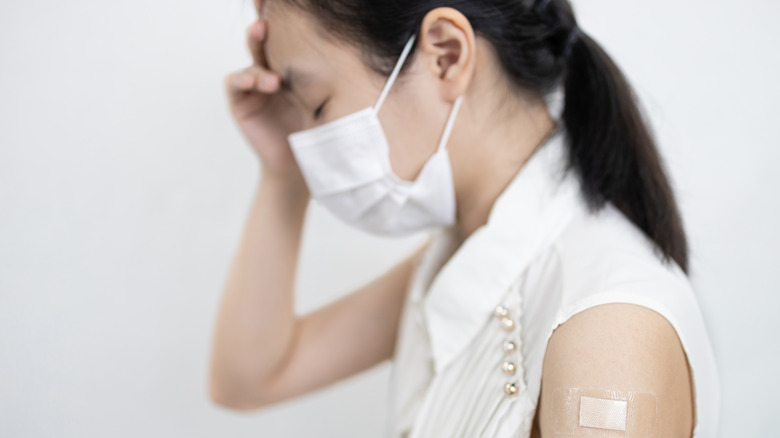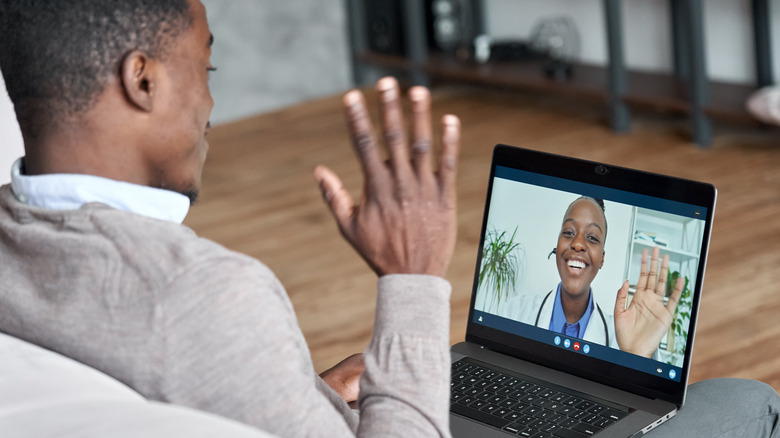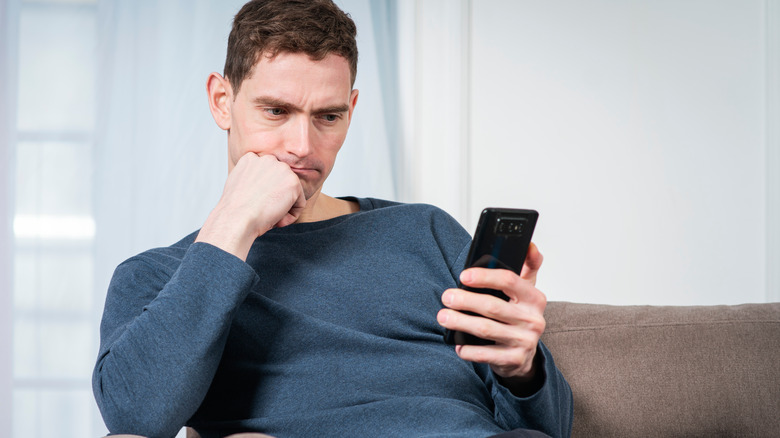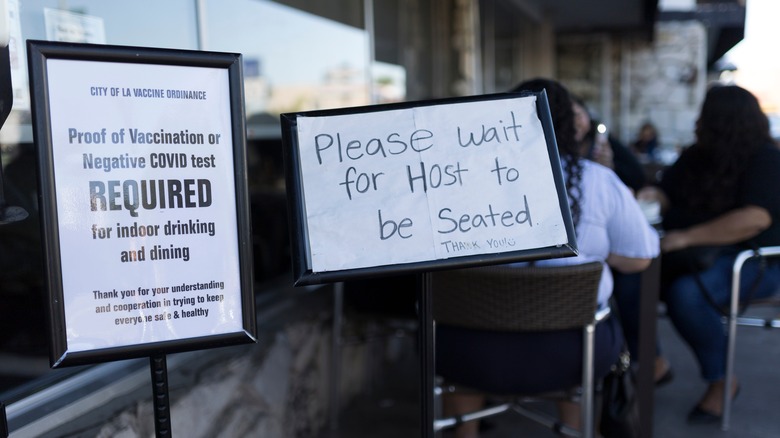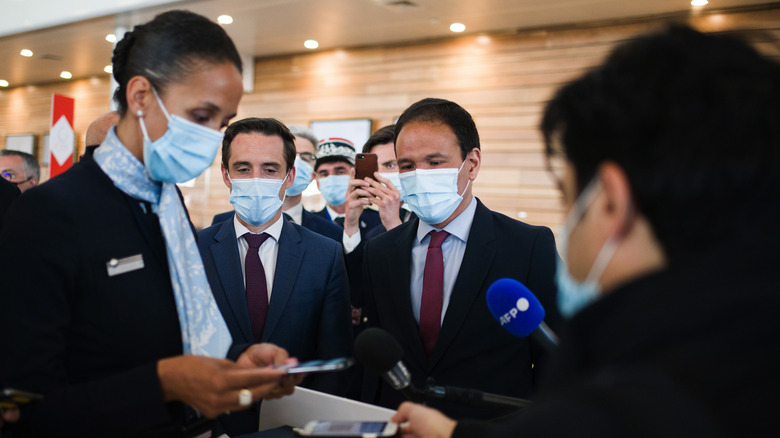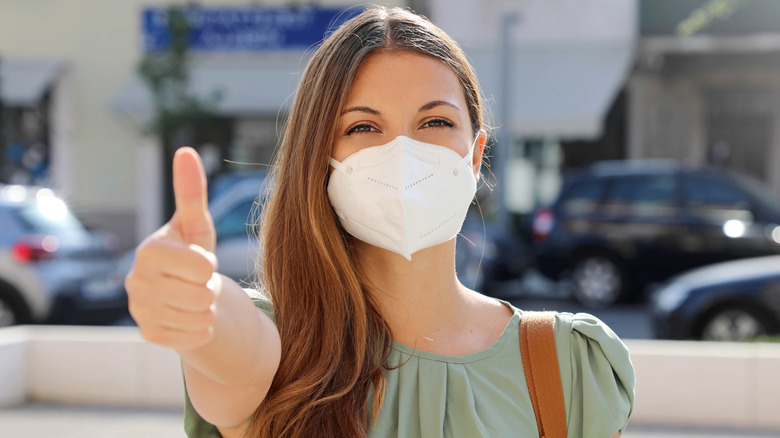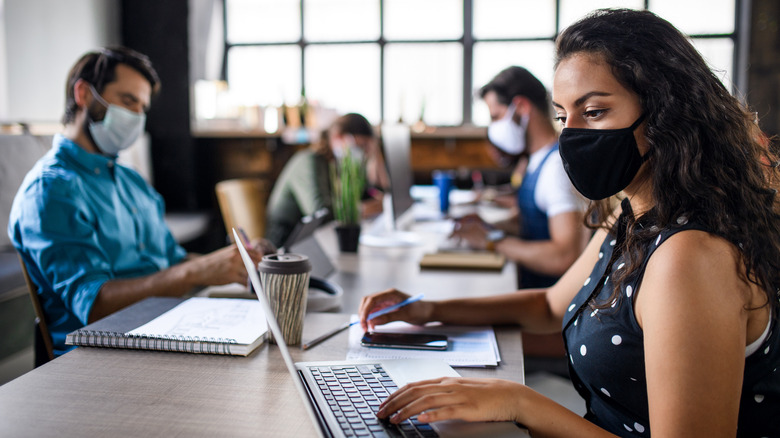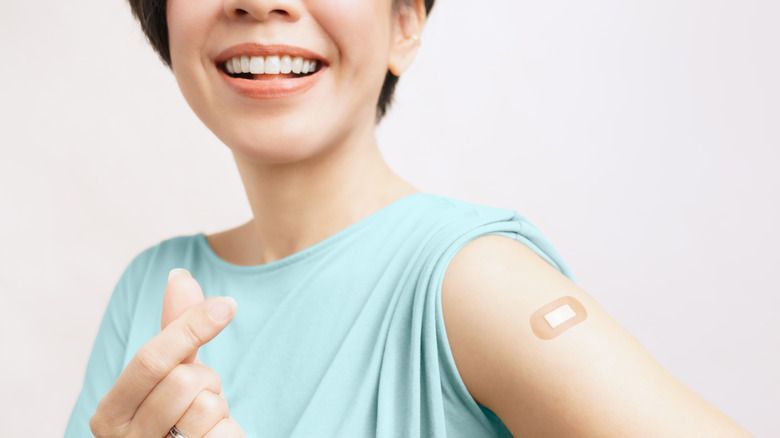Things You Should Do After Getting Your COVID-19 Booster Shot
If you're reading this, then perhaps you're basking in the afterglow of having received your COVID-19 booster shot — and knowing you've taken action to help reduce the spread of COVID-19 and increase your odds that you won't contract a severe form of this persnickety and mercurial virus. Or maybe you've made your appointment and are wondering what's going to happen after the needle stick. In either case, we'd like to take the opportunity to say, "go best friend," because if you're getting boosted, you're one of the more than 70 million Americans who are following official public health recommendations aimed toward stopping the pandemic and getting "normal" life — whatever that is now — back on track.
More to the point, however, you're doing the right thing in figuring out what you'll need to be doing after you get your COVID-19 booster, including everything that you'll need to be doing from moment the kind healthcare worker with the hypodermic needle (gently) puts that little adhesive bandage on your arm. Of course, you'll also want to make sure you know the things you shouldn't do after getting your COVID-19 booster. For the moment, though, let's keep our focus on the things you should be doing after your COVID-19 booster shot.
Update your COVID-19 vaccination record card
Wherever you're planning on receiving your booster shot, the vaccine center will most likely provide simple instructions in advance of your appointment, including the instruction to bring your existing COVID-19 Vaccination Record with you to your appointment, per the Centers for Disease Control and Prevention (via the CDC). That means the actual card, unlaminated. Although a digital photo of your card will help your vaccine center to confirm that you have already been fully vaccinated, you'll still need the actual card with you so that you can update your vaccine record with your booster information, including the manufacturer, lot number, and date of your appointment.
If you can't locate your card, or if you never received a card when you were vaccinated initially, a representative from CVS told Health Digest to do the following: At the time of your booster shot, ask the healthcare worker who is administering your shot to confirm for you the manufacturer and lot number for your booster shot. Write it down, and keep it in a safe place, and when you have your vaccine card in hand once again, make sure to add this information — and then take another photo of your card.
Stick around during the specified observation period
The technology behind the Pfizer and Moderna COVID-19 vaccines/boosters isn't new; it's been in development for more than 15 years, per the CDC. And all the COVID-19 vaccines/boosters that are subject to emergency use authorization (EUA) in the United States have been clinically proven effective at mitigating the spread of COVID-19 and reducing the risk of contracting a severe form of the illness. At the same time, they have also been found to be safe. Just to be clear on what that means, the CDC states that all of the COVID-19 vaccines subject to EUA "were evaluated in tens of thousands of participants in clinical trials" and "met the Food and Drug Administration's (FDA's) rigorous scientific standards for safety, effectiveness, and manufacturing quality." Further, "millions of people in the United States have received COVID-19 vaccines under the most intense safety monitoring in U.S. history."
Part of that monitoring has involved asking that vaccine/booster recipients remain at the vaccine center for "observation" for anywhere from 15 to 30 minutes after injection (via the CDC).
In late December, the U.K. temporarily suspended the observation requirement, due to logistical issues that don't necessarily apply to your vaccine center or in the U.S. at all (via Times of India). However, the U.K.'s decision was not meant to suggest that the observation period is optional. As noted above, the observation period is critical to the scientific evaluation of adverse events in connection with the COVID-19 vaccines and boosters.
If you start to experience any adverse effects while you're waiting, be sure to speak up
The CDC notes in its booster shots literature that side effects following injection are possible — whether immediately or after a period of hours or even days. Side effects are considered "normal signs that your body is building protection against COVID-19." The observation period that is standard following COVID-19 vaccine and booster injections was primarily put in place to record and address any immediate acute reactions, but such reactions have been observed only in rare cases (via the CDC).
Hopefully, your own COVID-19 booster observation period will have gone by — or will go by quickly — and without incident. However, if you have any doubts or questions during the observation period — or you think you're having an allergic reaction — let medical personnel at your vaccine site know immediately so that your issues may be addressed while you are still on the premises.
Those with a history of serious allergic reactions should prepare to wait up to 30 minutes
What clinicians are most concerned about during the observation period after injection of a COVID-19 vaccine is anaphylaxis, according to the CDC. Anaphylaxis, which is rare to begin with, is an "acute and potentially life-threatening allergic reaction" (via the Mayo Clinic). The Mayo Clinic notes the most common triggers for anaphylaxis are foods, although it also may occur in connection with taking medication (as well as insect stings and exposure to latex). Anaphylaxis has been observed in only rare cases following an EUA COVID-19 vaccine/booster (via the University of Michigan). For example, the CDC says that safety monitoring of the Pfizer vaccine against COVID-19 (in the United States from December 14-23, 2020) has detected just 21 cases of anaphylaxis in 1,893,360 doses (11.1 cases per million doses). The CDC noted that "71% of these occurred within 15 minutes of vaccination."
If you have no allergies to medications, have never experienced anaphylaxis, and especially, if you didn't experience a severe immediate reaction in connection with your initial COVID-19 vaccine or vaccine series, then the risk that you will experience anaphylaxis from your COVID-19 booster shot becomes even smaller. However, all vaccine sites are required by the FDA to be ready to deploy immediate emergency care in the event a vaccine recipient experiences signs of anaphylaxis.
Here is how you can tell if you are having an allergic reaction and what anyone with known allergies should know in advance of getting their COVID-19 booster shot.
As the hours pass, you may begin to experience fever, headache, fatigue, and pain at the injection site
All medications that are available by prescription and over the counter have the potential to cause side effects, according to Dr. Michael Bihari, via VeryWell Health. Of course, the EUA COVID-19 vaccines/boosters are no different. So side effects are to be expected and tend to present within 24 hours after the injection (via Hackensack Meridian Health). In fact, you might even consider looking at them in a "friendly" kind of way because experts say that the side effects from the EUA COVID-19 vaccines/boosters may be telling you that your immune system is putting together its plan of attack for when and if you become exposed to the novel coronavirus that causes COVID-19 (via the CDC).
Specifically with regard to boosters, the CDC has stated that "reactions reported after getting a booster shot were similar to those" observed after getting the "primary" vaccine or vaccine series. In other words, the most common side effects include redness, swelling, and pain at the injection site, fever, headache, tiredness, muscle pain, chills, and nausea, according to the CDC. Overall, side effects have been mild to moderate. More serious side effects are possible but rare.
Serious side effects are also possible, but they are rare
According to the CDC, the systems that have been put in place to monitor the safety of COVID-19 vaccines have found four types of serious side effects, which they refer to as adverse events. The first is anaphylaxis, which is rare, according to the Mayo Clinic. Anaphylaxis tends to present immediately after exposure, which, in the case of COVID-19 booster shots, means within 15 to 30 minutes after shot administration — so while you are still being observed after having received your injection.
The next side effect is heart inflammation, which is also rare and can present as either myocarditis (inflammation of heart muscle) or pericarditis (inflammation of the heart's lining), according to the CDC. The third is Guillain-Barré Syndrome, another rarity, and which causes neurological symptoms (via the Mayo Clinic).
Thrombosis with thrombocytopenia syndrome (TTS) is the fourth side effect, which is not only rare but seen primarily in those who received the vaccine manufactured by Johnson & Johnson (via Hematology). Because of this, and because of concerns that the Johnson & Johnson COVID-19 vaccine may not be as effective as the Pfizer or Moderna vaccines against COVID-19, the CDC has taken steps to narrow use of the Johnson & Johnson vaccine, according to NPR.
What to do if you suspect your side effects are serious or life-threatening
Any side effects that you may experience after getting a COVID-19 booster shot may have the potential to interfere with your ability to engage in your everyday activities, according to the CDC. However, this does not mean your side effects are necessarily serious or life-threatening. That being said, if you find that your side effects are not getting better after a few days, the CDC advises calling your healthcare provider. In addition, you'll want to check in with a healthcare provider if your side effects seem to be getting worse after the first 24 hours after your COVID-19 booster shot.
Of course, any time you are in doubt about a side effect or other symptom, it's reasonable to check in with your healthcare provider. Further, if you feel that your side effects are rising to the level of an emergency situation, you should call 911 or go to the emergency room. But again, the odds of this happening after your booster shot are small.
The CDC asks that you report any side effects using its V-Safe platform
In the unlikely scenario that you experience serious side effects from your COVID-19 booster shot — and you seek medical assistance — your healthcare provider is expected to make a record of the occurrence of an adverse reaction and notify the CDC of the same. If your side effects are minor such that they don't require you to see a medical professional, then ideally, you will report your side effects to the CDC. Doing so is as easy as logging in to the V-Safe app provided by the CDC.
V-safe is a "smartphone-based tool that uses text messaging and web surveys to give personalized health check-ins after you receive a COVID-19 vaccine," the CDC explains. This app was designed to make it easy and fast to notify public health authorities that you have experienced side effects after receiving a COVID-19 vaccine. Although this information is private under HIPAA (via the CDC), it is very important in the name of public health because it helps the CDC, and theoretically, other public health authorities, monitor the vaccine/booster's safety in "near real time."
Carry your vaccine record card with you wherever you go
If it felt annoying to dig your official Vaccination Record card out of your desk or wherever you were stashing it in order to get boosted, now would be a good time to accept that your COVID-19 vaccination card is becoming "just as necessary as your debit card," according to the Philadelphia Inquirer.
Since November 8, 2021 anyone flying into the United States has had to present proof of vaccination against COVID-19 — with only limited exceptions — and that includes U.S. citizens, according to federal regulation. The federal government has been gradually but steadily moving toward imposing vaccine requirements on American workers, starting with federal employees and branching out into the private sector (via the White House Fact Sheet and Forbes). Outside of specific federal legislation, many private businesses are entitled to impose whatever vaccine mandates they choose, as long as they don't violate any applicable law. However, thus far, state governments are divided on whether to impose state-mandated proof of vaccine requirements (via Ballotpedia).
Since the 50 states are all over the place with regard to vaccine mandates, and within individual municipalities, the rules may vary depending on the desires of individual private business owners (e.g. restaurants, clubs). If you want to move about freely you'll want to keep your vaccine card close.
You'll need proof of having had the COVID-19 booster to enter some countries
The United States has not yet legislated that those entering the country must present evidence of having had a booster shot against COVID-19. However, eight countries have. These include Croatia, Kuwait, The Netherlands, Israel, Austria, Greece, Switzerland, and France, according to Time of India. The rule is already in effect in Kuwait, France, Croatia (which specifically requires proof of the booster within 365 days of entry to the country), Israel (which requires the final vaccine dose to be within 180 days of one's entry into the country), and Austria (which has now enacted vaccine mandates for all citizens), Greece (which has made vaccine passports mandatory in many indoor spaces, and to get a vaccine passport, one must have received a booster).
The Netherlands has given people until February 2022 to comply with the booster-shot mandate. Switzerland, like Croatia, now requires proof of vaccination within the last 365 days before traveling. However, one can enter the country without a Swiss vaccine passport but won't be allowed to enter many of Switzerland's indoor spaces (no word yet on whether that includes hotels!).
Know that your immune system is being taught to fight off COVID-19
The reason why public health authorities are so keen to have as many people as possible vaccinated and boosted against COVID-19 is that all of the EUA COVID-19 vaccines are designed to teach your immune system how to recognize exposure to the novel coronavirus — and how to beat it back so that one either doesn't become sick with COVID-19 or experiences only mild symptoms, according to the CDC.
What the booster does is "boost" the immune response your immune system has already learned in connection with whatever primary vaccine or series you received, making it "bigger, better and faster, and really locking in the memory of it," according to Beth Moore, the Interim Chair and Professor of Microbiology & Immunology at Michigan Medicine, via University of Michigan Health Blog. Moore was referring specifically to the mRNA vaccines/boosters, the ones made by Moderna and Pfizer. However, the same generally applies also to the Johnson & Johnson vaccine and whatever booster you may end up getting (and you are now free to mix and match, according to the FDA). Although the Johnson & Johnson vaccine/booster is now lagging behind in use and availability across the United States, a full 870,000 individuals had received the Johnson & Johnson booster as of December 15, 2021 (via NPR).
For now, you're advised to keep your mask on when indoors in public locations
As with vaccine mandates, the United States as a whole is not in agreement as to whether masking should be required and under what circumstances. According to the AARP, as of January 3, 2022 eight states require masks in indoor public places, regardless of vaccination status. These are California, Hawaii, Illinois, Nevada, New Mexico, New York, Oregon, and Washington (Washington requires masking even at outdoor events that are attended by 500 or more people). In addition, Washington, D.C., along with the territory of Puerto Rico have imposed similar orders.
Connecticut, by contrast — which dropped its state-mandated mask requirement early on in the pandemic and then reimposed it only to drop it again — has now re-reimposed a masking mandate applicable only to the unvaccinated, noted AARP. Other states such as Rhode Island, for example, require masking at large venues but allow smaller businesses to decide for themselves based on the vaccination status of those seeking to enter those businesses. And within states that do not impose masking mandates, there can be great variation among the various municipalities, and again, among private businesses. What is absolutely certain, however, is that the CDC recommends masking, regardless of vaccine status, "in health care and long-term care facilities, prisons, homeless shelters, on public transit, and in transportation hubs like airports and bus and train stations," with most states making efforts to follow along (via AARP).
Fully vaccinated
In the CDC's eyes, one is considered "fully vaccinated" against COVID-19 within two weeks after receipt of their full primary vaccine series, whether that is two doses of an mRNA vaccine or one dose of Johnson & Johnson. "Administration of an additional primary dose or a booster dose is not required to be considered fully vaccinated for public health purposes at this time," the CDC points out. Further, despite that all three of the EUA COVID-19 vaccines have been demonstrated to offer different levels of protection — and despite that the CDC foresees people mixing and matching their vaccines and boosters based on availability — the CDC is currently making no distinction between the various vaccines or vaccine/booster combinations.
If, at this point, you find yourself wondering why you bothered to get a booster if currently most governments aren't checking that specifically, it's worth remembering that the knowledge-base and the related rules regarding COVID-19 have evolved uber-rapidly over the course of the COVID-19 pandemic. In other words, it's entirely possible that the rules will change so that boosters are required for "full vaccination" status to be maintained. Most importantly, the booster shot can increase your body's resistance to the novel coronavirus when exposed and can keep you from getting severely ill even if you do end up catching COVID-19.

